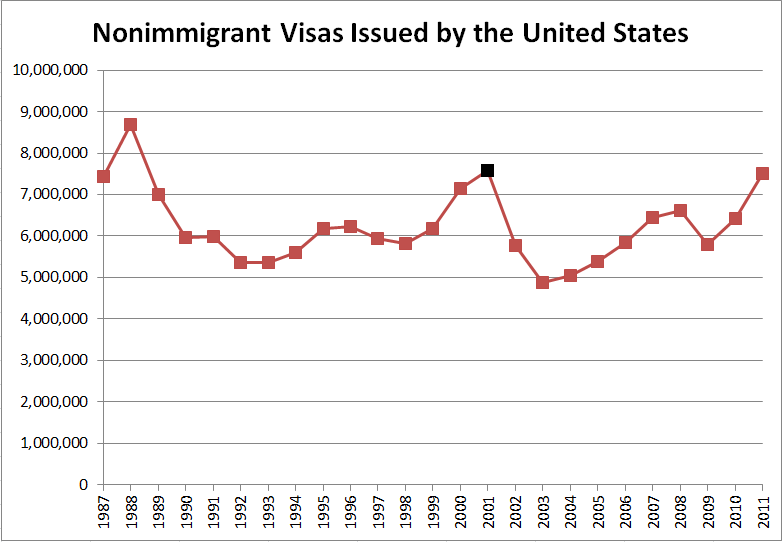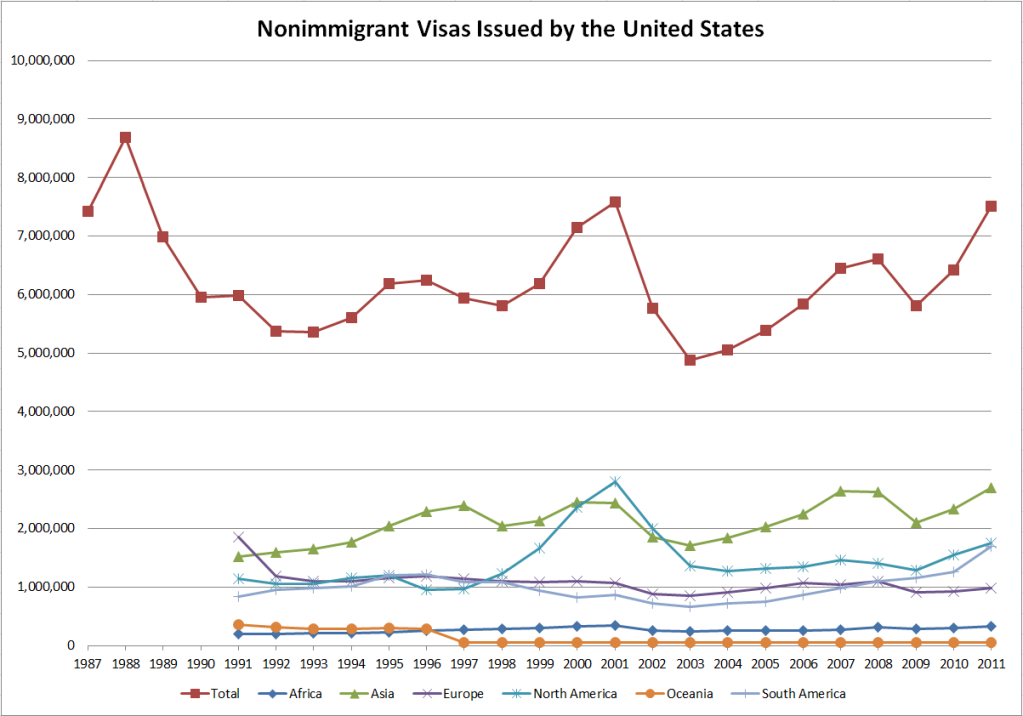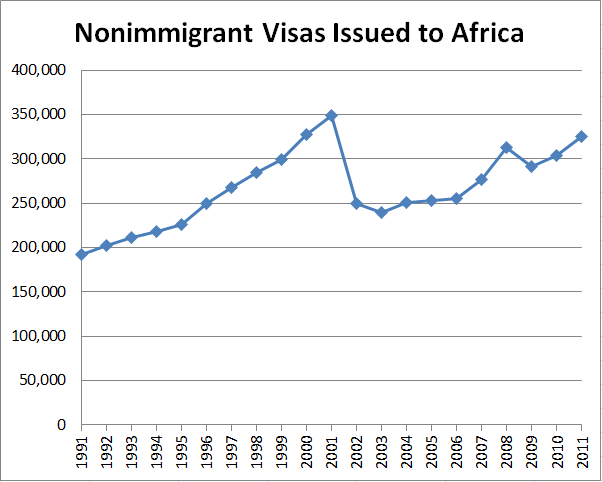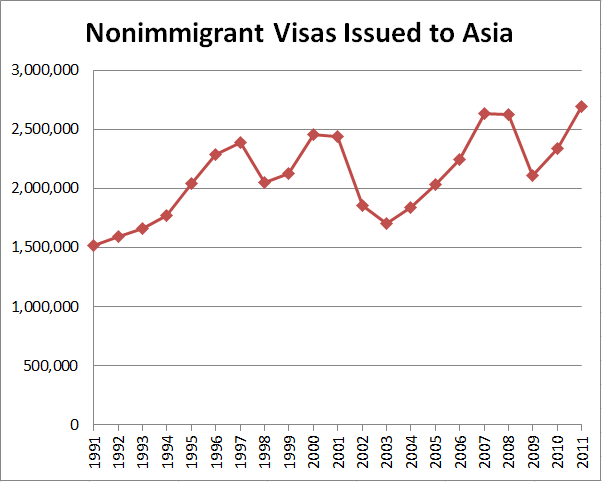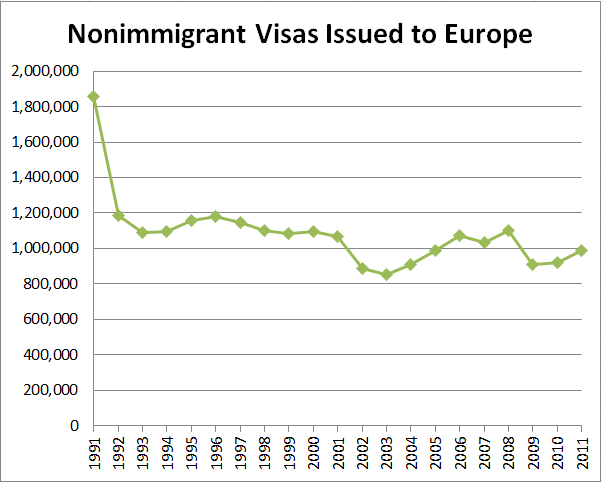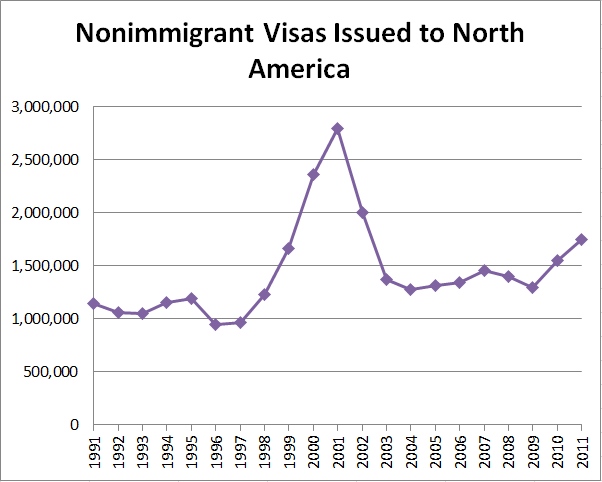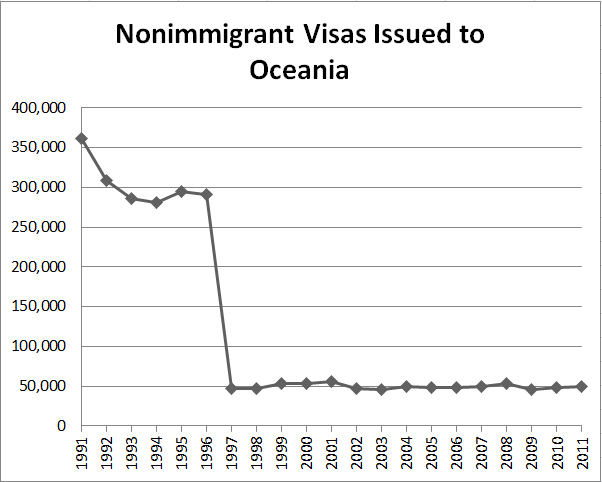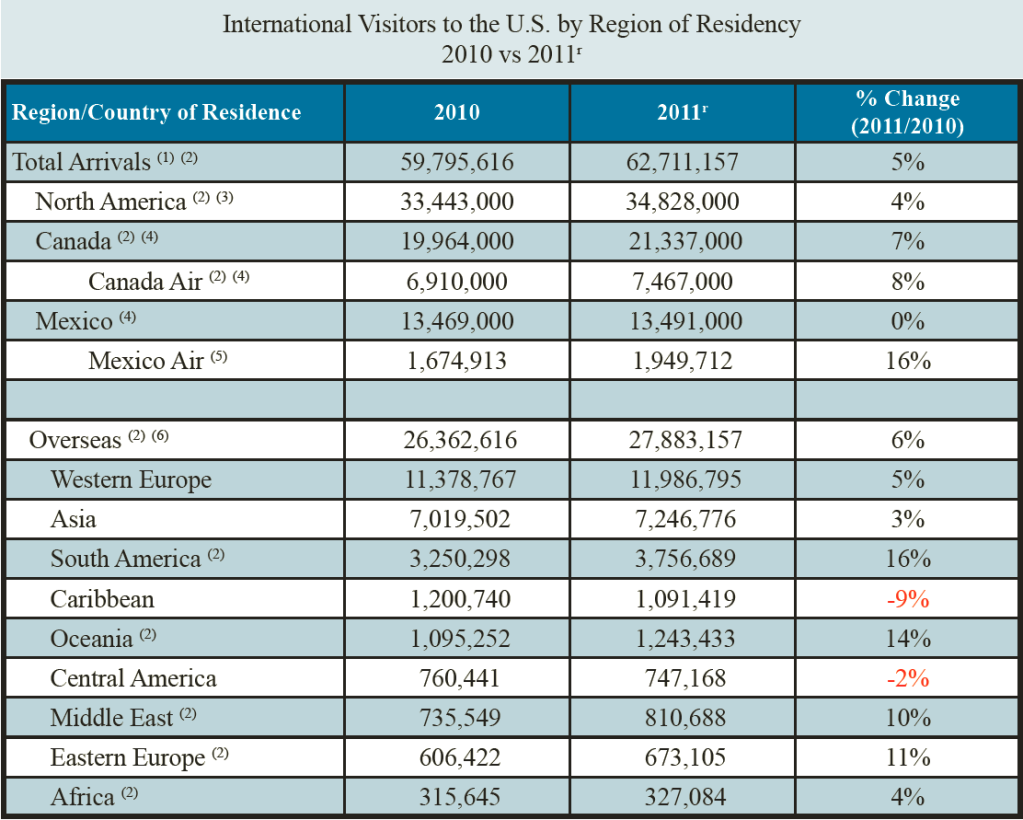By: inoljt, http://mypolitikal.com/
A lot of people visit America. According to the latest estimates, about sixty million people came in 2011.
One interesting way to track tourism in America, and by association the country’s openness, is through looking at the number of nonimmigrant visas granted to other countries. The State Department has a number of interesting statistics on the issue, which can be accessed here, here, and here.
More below.
Let’s take a look at the statistics. Here is the total number of nonimmigrant visas granted by the United States:
Nonimmigrant visas are essentially tourist visas, although they cover a bit more than that (for instance, they might include special visas for diplomats or airline staff). In theory they provide a good, albeit somewhat exaggerated, estimate of the number of tourists from poor countries who go to America each year.
There are quite a few interesting things in this graph. Firstly, there are a lot fewer than sixty million visas issued. This is because the vast majority of tourists in America come from countries in which visiting America doesn’t require a visa. These countries are places such as Japan and Germany, which send very few immigrants to the United States.
There is also something to be said about the number of visas issued. It’s worth noting that America issued the highest number of visas in 1988, more than two decades ago. Nonimmigrant visas then declined greatly in the early ’90s, before rising again. In the aftermath of 9/11 the number of visas issued declined once more; indeed, America still issues fewer visas than before 9/11. The opportunity cost in lost tourist revenue due to these restrictions is unknown, but probably fairly significant.
Let’s take a look by continent:
I could only get continent data up to 1991. Nevertheless, the data is quite interesting. The highest number of visitors to America from poor countries come from Asia and North America, although South America’s share is rising.
Here is a better look:
One can see a lot more detail here. The patterns by continent are very different.
Let’s take a look by continent, ordered alphabetically. Here is Africa:
Nonimmigrant visas issued increased substantially until September 11th, upon which time the harsher security measures drastically cut visas. Not many Africans visit America; only several hundred thousand are allowed per year.
Here is Asia:
A lot more Asians from poor countries visit America than Africans from poor countries. The pattern is somewhat similar to that of Africa. There is a gradual increase, then a decline after 9/11, then another increase in tourists. The affect of the 2009 recession is much more apparent here, decreasing visitors substantially.
Let’s look at Europe:
Europe is quite different. Nonimmigrant visas issued to Europeans seem to be declining rather than increasing. There’s a huge decline from 1991 to 1992. This was when Andorra, Austria, Belgium, Denmark, Finland, Iceland, Liechtenstein, Luxembourg, Monaco, Norway, San Marino, and Spain joined the visa waiver program (so residents no longer needed visas to visit the United States).
One ought to note that a large portion of European visitors to America come from rich countries, which means that they don’t need a visa to visit America. So this graph covers places like Ukraine and Serbia but not France or Italy. It misses tourists from most of Western Europe.
Let’s look at North America:
North America is strange. For some reason there’s an enormous increase in visas issued prior to 9/11. Then the number of visas steeply decreases and remains substantially below the level in 2001. This seems kind of strange and stupid. It’s understandable that scrutiny of potential tourists would increase after the September 11th attacks. But terrorists attacking the United States generally do not come from North America.
Here is Oceania:
Most of Oceania is Australia, and there was a dramatic decrease in visas issued to Australians after 1996. This was when Australia joined the visa waiver program. Since the rest of Oceania is so insignificant, few visas go to Oceanians.
Finally, here is South America:
South America is different from all the above continents. Visas issued to South Americans declined substantially starting from 1996. There was no big September 11th effect (probably smart, since few terrorists attacking the United States are South American). Since then, nonimmigrant visas given to South Americans have risen, unaffected by the 2009 recession. There was a substantial jump in 2011.
Finally, there is something quite strange about all these statistics. Let’s take a look at what another agency – the Department of Commerce – says about tourists visiting the United States:
The two sets of numbers simply don’t match. The Department of State only issued 7.5 million nonimmigrant visas in 2011. Yet according to the Department of Commerce, 62.7 million people visited the United States in 2011.
Part of this – but only part – is accounted for by the fact that the majority of tourists in America come from rich countries. To visit America, people from these countries don’t require visas. So the State Department statistics don’t count them. Only 6,477 nonimmigrant visas were issued to Canadians in 2011, for instance. But 21.3 million Canadians visited the United States in 2011.
However, that can’t be all the answer. The Department of Commerce states that 13.4 million Mexicans visited America in 2011. Yet only 1.3 million nonimmigrant visas were granted Mexicans in 2011, according to the State Department. The same pattern holds for South America; South America’s Department of Commerce numbers are double the Department of State’s numbers. Only in Africa is there somewhat of a parity between the two sources. None of the above-mentioned countries or regions qualify for the visa waiver program, so one would expect the Department of Commerce’s numbers to be below – not above – the Department of State’s numbers. What gives?
Of course, the State Department has an incentive to underestimate visitors; its mission is to view people entering America as potential threats. The Department of Commerce views them as opportunities for tourism and revenue; it’s inclined to overestimate visitors.
All in all, it’s kind of a missed opportunity that the number of nonimmigrant visas granted by the United States hasn’t increased in two decades. Tourism both helps the American economy and generally improves the American image. On the other hand, it seems that despite this the number of tourists visiting the United States has generally been on the rise. That’s a good thing.
